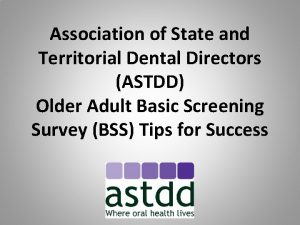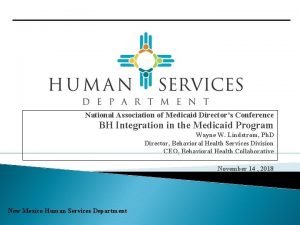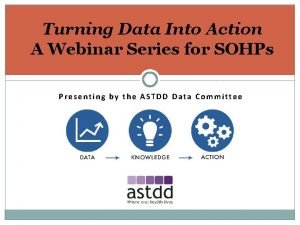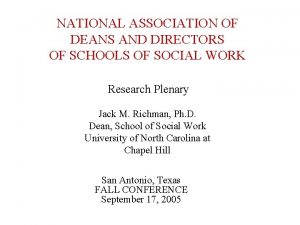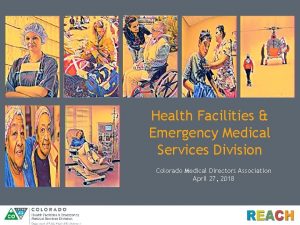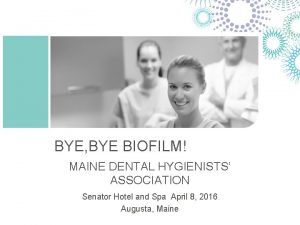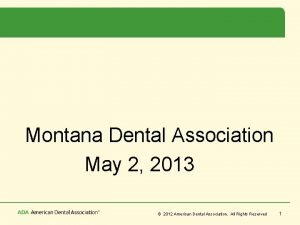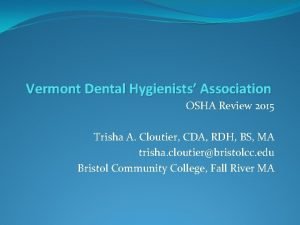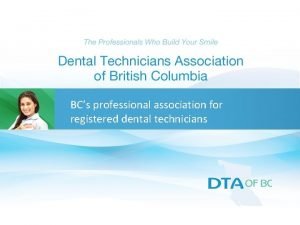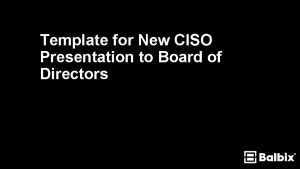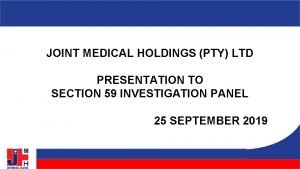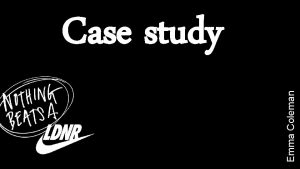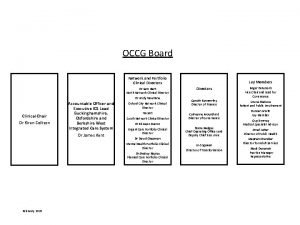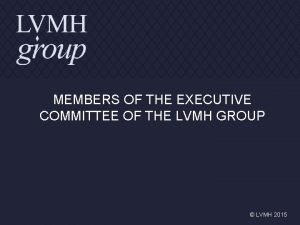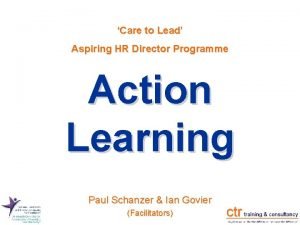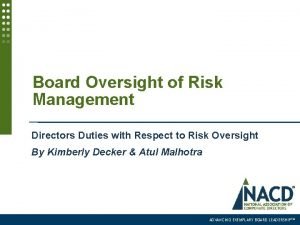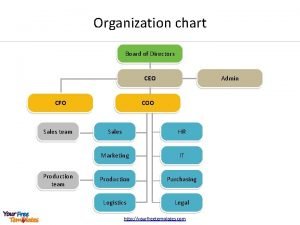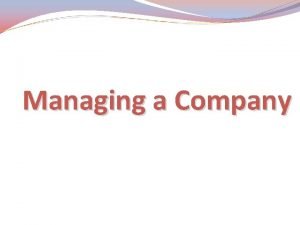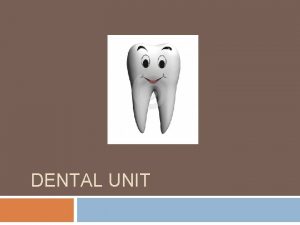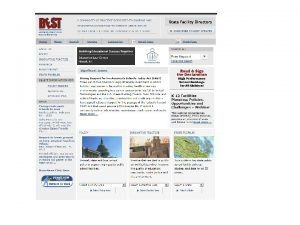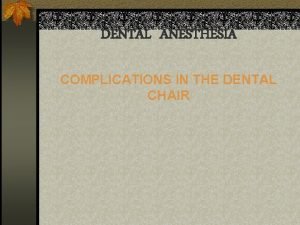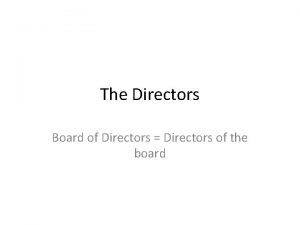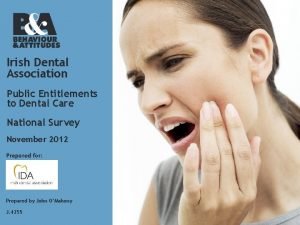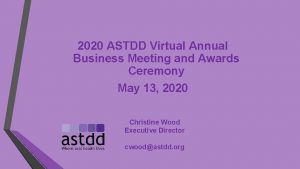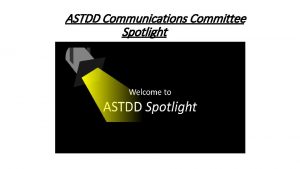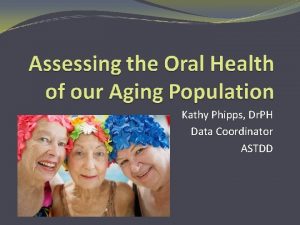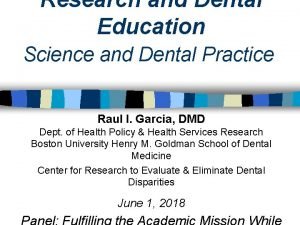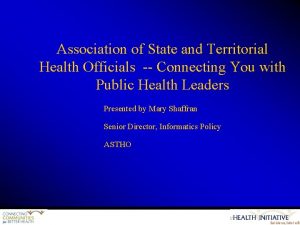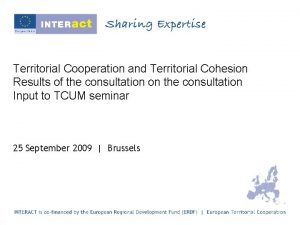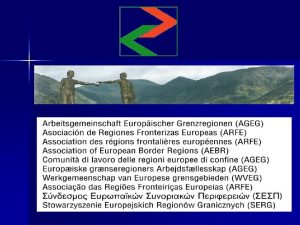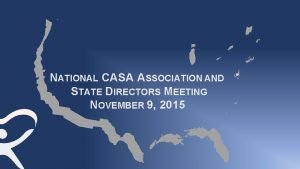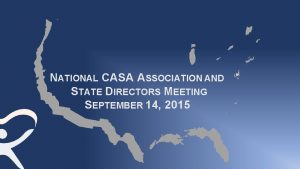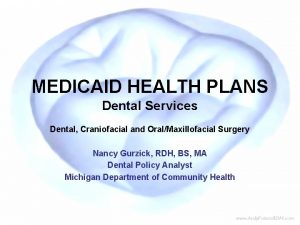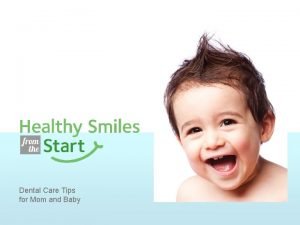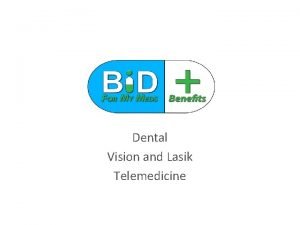Association of State and Territorial Dental Directors ASTDD



























- Slides: 27

Association of State and Territorial Dental Directors (ASTDD) Older Adult Basic Screening Survey (BSS) Tips for Success

Why Do We Need An Older Adult BSS? Ø Population is aging— 10, 000 people each day turn 65 years old! Ø Oral health is integral to overall health across the lifespan. Ø Data are needed to show the burden of disease in this population. Ø Data support efforts to increase funding for access to care. Ø We need data to “tell the story. ”

http: //www. astdd. org/healthy-aging-committee/

Older Adult BSS Tips for Success Purpose: The ASTDD Healthy Aging Committee received input from states saying they would like information from other states that have completed the Older Adult BSS. The Older Adult BSS Tips for Success asks states to share: • • • Funding resources Documents/forms Lessons learned Flyers Marketing tools

States that have completed an older adult BSS as of 12/2016 • • • Alaska Arkansas California Connecticut Florida Georgia Kansas Maryland Massachusetts Michigan Missouri Nevada New Hampshire North Carolina North Dakota Oregon Rhode Island Vermont Virginia *Washington (phone survey only) • West Virginia • Wisconsin • • •

States with Published Reports • ASTDD’s Data Committee keeps an updated list of states that have completed an Older Adult BSS and has links to reports on the ASTDD website: http: //www. astdd. org/data-collection-assessment-and-surveillance-committee/ • Scroll down the page to: States with Oral Health BSS Data

Funding Sources States reported receiving funding for an Older Adult BSS from: • Centers for Disease Control and Prevention ( CDC) • National Association of Chronic Disease Directors (NACDD) • Delta Dental Foundation • Denta. Quest Foundation • Private community foundations • State Department of Aging

Where to Start? • Select a person to oversee coordination of the BSS project. • Review ASTDD BSS Toolkit – Toolkit is FREE to ASTDD members! Log on to the ASTDD Members Only page. – Not a member of ASTDD? Fee is $10 including shipping: http: //www. astdd. org/basic-screeningsurvey-tool

Where to Start? • Review past data collected in your state. • Select a population group and work with an epidemiologist on how to sample that population; ASTDD can assist you. Contact: – Dr. Mike Manz: mmanz@umich. edu – Dr. Kathy Phipps: kathyphippps 1234@gmail. com • Potential sample population locations: – Congregate Meal Sites – Long-Term Care Facilities – Assisted Living Facilities • Seek funding or in-kind and volunteer resources.

Next Steps • Who can help make this project successful? – Partners – Screeners – Funders – Others? – Contact an ASTDD Older Adult BSS Coach, if needed, at any point in the process: Lori Cofano: lkcofano@gmail. com Jill Moore: moorej 14@michigan. gov

Review Existing Resources • Don’t reinvent the wheel! – ASTDD Older Adult BSS Toolkit – Evaluations – Reports – Data collection documents – Patient surveys – Marketing posters • Ask ASTDD members for resources via ASTDD listserv: members@groups. astdd. org

The BSS Process *Courtesy of Eli Schwartz, NOHC presentation 2015 1. Identification of existing data and policy documents with relation to seniors’ oral health care 2. Contact state and county agencies on aging to seek support 3. Identification of funding source 4. Application and approval from Institutional Review Board (IRB) *Note: States should look into applying for IRB exemption or waiver first 5. Development of invitation letters, oral health screening forms and surveys

The BSS Process (Continued) 6. Sampling (with assistance from ASTDD) 7. Organizing screening instruments, equipment, and oral health items such as toothbrushes, floss, denture brushes, etc. 8. Conduct trainings or calibrations; screening; and questionnaire surveys 9. Follow-up 10. Analysis and reporting Adapted from “Implementation Steps of a County-wide Oral Health Basic Screening Survey of Seniors” roundtable presentation, NOHC 2015, Eli Schwarz, DDS, MPH, Ph. D, Oregon Health Science University, Dept. of Community Dentistry

Lessons Learned: Planning Ø Start planning EARLY! (ASTDD Older Adult BSS Manual suggests 9 -12 months. ) Ø For seniors who are homebound, collaborate with the agency that serves Meals on Wheels and include oral health messages and information about the screenings on the back of their menu cards; they are usually printed ahead of time, so that will take planning. With enough notice even most homebound residents can get transportation. Ø Assisted living facility—nice because you could spend the day there, but success will be directly linked to the director, especially going to get residents from their rooms

Lessons Learned: Planning Ø At senior centers, announce the screening for a longer period of time than you think you need to in newsletters, on their website, at each meal that is served. Unfortunately (or fortunately) seniors have a lot going on and unless its kept on their radar, they will do something else that day and not show up. Ø Faith-based locations are positive because people know each other, are friends, and will encourage each other to participate. Ø Realize that staff turnover in long-term care facilities is fairly high; you may deal with several different individuals throughout the approval and scheduling process.

Lessons Learned: Planning ØLet the location know in advance what type of space you will need to set up for the screening and if you will need tables, chairs, power, etc. ØIf your target population is those age 65 and older, you may encounter younger individuals at the screening location. If they insist on being included, data cleaning and analysis can compensate. Ø Prepare a list of possible dental offices/clinics for referrals if they aren’t already receiving care.

Lessons Learned: Planning Ø Activities at sites—good to get people there, hard to pull them away. Good to make “time” for screening so that they do not feel like they are missing out on the activities Ø An engaged congregate meal site coordinator is invaluable — knows seniors by name, speaks of the event in a positive tone, encourages them to participate, explains why this is important for them (cancer screen) and their peers who may not have access to oral care (data collection); rely on coordinator to help identify best day to hold event. Ø Try to schedule screening when bingo, the hairstylist/manicurist or preacher are not there. Dental screening cannot successfully compete with any of these.

Lessons Learned: Planning Ø Consider having a sign-up list for specific times in advance so they aren’t frustrated waiting around. One state allowed 15 minutes person; remember they want to talk! Ø Be mindful of conducting the screening in long-term care facilities during winter months – flu season can hamper access to facilities. Ø Long-term care facilities may want a consent form for their records; they usually have generic forms that can be easily modified. Ø Consider how data will be collected (real time vs. paper. ) Depending on how “tech savvy” the screeners are, paper forms may be the best route.

Lessons Learned: Planning Ø Type of screening site impacts data. Do you want moderate risk older adults? Select meal sites. Do you want data on vulnerable older adults? Select long-term care sites. Ø Congregate meal sites are more likely to participate than longterm care facilities. Ø Long-term care facilities may view the screenings as an “audit” and may refuse or ignore your attempt to contact them.

Lessons Learned: Supplies Ø Need nice freebies (incentives)! Ø Bring enough toothbrushes, toothpaste, etc. to distribute to personnel, nursing staff, janitorial crew, etc. Ø Bring a few sippy cups; persons with hand tremors or weakness may spill the water from a regular cup. Ø Complete two assessment forms, one with the senior’s screening number for the oral health program to use/keep and a second form that includes the senior’s name so that any needed dental care, oral lesions, poor oral hygiene, etc. may be documented and the form given to the nursing director follow-up. The facility form should use understandable , nondental terms.

Lessons Learned- Supplies Ø Privacy screens are useful at congregate meal sites and assisted living facilities. Ø Privacy screens can serve a dual purpose by displaying oral health messages (see next slide).


Everyone loves incentives! Being organized makes things go more smoothly.

Other Lessons Learned Ø Posters and marketing materials help. Ø More women usually consent than men. Ø If one person wants to do it then friends will. Ø Senior health fairs: large energetic crowd, need extra screeners and barriers such as ropes to keep people in line. Ø Senior health fairs — Create coupons so they can come back to get free incentives so they don’t miss them.

Other Lessons Learned Ø Offer staff in-service to increase likelihood that a facility will agree to participate. Ø Hold a debriefing with your primary contact at the facility at the conclusion of the survey to discuss seniors that need dental treatment, helpful hints for oral hygiene, etc.

Resource Documents From Other States Ø Maryland FAQs brochure: https: //www. astdd. org/www/docs/md -dr-des 23013 -older-adult-bpar-faq-2016. pdf Ø Maryland Health questionnaire: https: //www. astdd. org/www/docs/md-dr-des 23013 -older-adultbpar-health-questionaire. pdf Ø Maryland Screening form: https: //www. astdd. org/www/docs/md-dr-des 23013 -older-adultbpar-bss-screening-form. pdf Ø Georgia Oral Health Coalition –Older Adults and Oral Health flyer: http: //www. astdd. org/docs/seniors-OH-flyer-georgia. docx

Older Adult BSS Coaches v Jill Moore RDH, BSDH, MHA Dental Sealant Coordinator Michigan Department of Health and Human Services Email: Moore. J 14@Michigan. gov Phone: 517 -373 -4943 v Lori Kepler Cofano, BSDH Dental Public Health Consultant Email: lkcofano@gmail. com Phone: 775 -781 -1722
 Association of state and territorial dental directors
Association of state and territorial dental directors National association of state medicaid directors
National association of state medicaid directors Astdd wiki
Astdd wiki National association of deans and directors
National association of deans and directors Thai institute of directors association
Thai institute of directors association Colorado medical directors association
Colorado medical directors association Introduction to hospitality 7th edition
Introduction to hospitality 7th edition Maine dental hygiene association
Maine dental hygiene association Montana dental association
Montana dental association Vermont dental hygiene association
Vermont dental hygiene association Dental technician association of bc
Dental technician association of bc Annulene aromaticity
Annulene aromaticity Cyber security posture presentation
Cyber security posture presentation Namata board of directors
Namata board of directors Role brief
Role brief Joint medical holdings
Joint medical holdings Directors emma wolverson
Directors emma wolverson Board of directors compliance training
Board of directors compliance training Board of directors kpmg
Board of directors kpmg German expressionist directors
German expressionist directors Clinical directors network
Clinical directors network Lvmh board members
Lvmh board members Aspiring directors programme
Aspiring directors programme Board of directors risk oversight responsibilities
Board of directors risk oversight responsibilities Nancy maher
Nancy maher Perfectionist directors
Perfectionist directors Coo cfo ceo
Coo cfo ceo Classification of directors
Classification of directors
